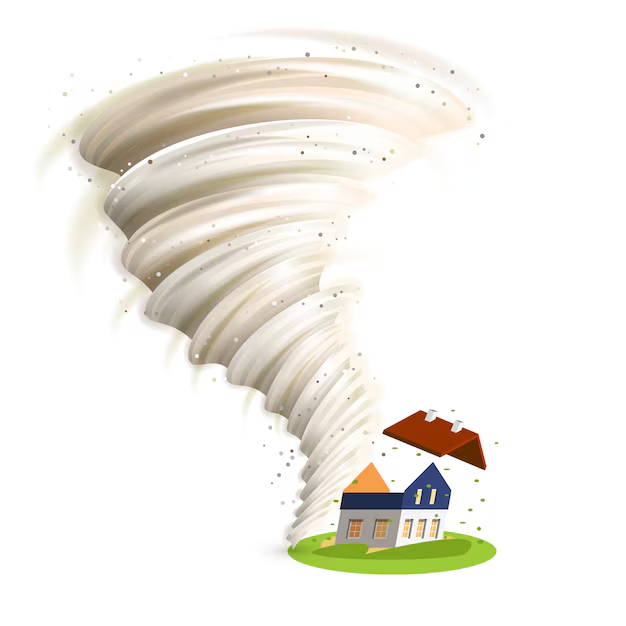BLOG
Milton Hurricane Update: Understanding the Impact and Recovery Efforts

As the 2024 Atlantic hurricane season continues, Hurricane Milton stands out as one of the most severe storms to hit the southeastern United States this year. Milton, a Category 3 hurricane, made landfall near Siesta Key, Florida, on October 9, causing widespread damage, power outages, and extensive flooding. This blog will cover the hurricane’s path, its impact on communities and infrastructure, and ongoing recovery efforts in the region.
Read more: milton hurricane update
Path and Timeline of Hurricane Milton

Hurricane Milton began as a tropical storm in the central Atlantic before strengthening and moving toward the Caribbean and southeastern U.S. coast. By the time it neared Florida, the storm had intensified into a Category 3 hurricane, with wind speeds reaching up to 125 mph. As it moved inland, the hurricane’s destructive power was felt across central Florida, bringing heavy rainfall, storm surges, and tornado activity.
Meteorologists had been closely monitoring Hurricane Milton’s path and potential impacts, issuing warnings days before landfall. These efforts helped some residents and businesses prepare by boarding up windows, evacuating flood-prone areas, and stocking up on emergency supplies. However, despite these precautions, Milton’s force was stronger than anticipated, leading to considerable damage.
The Widespread Impact of Hurricane Milton
The impact of Hurricane Milton has been devastating for many Floridian communities. At least 24 fatalities have been reported due to the hurricane’s direct effects, and thousands of residents were forced to evacuate as the storm’s path continued through central Florida. Flooding was particularly severe in coastal and low-lying areas, where heavy rainfall combined with storm surges to inundate streets, homes, and businesses.
Some of the most severe impacts include:
1. Infrastructure Damage: Power lines, roads, and bridges suffered extensive damage, complicating evacuation and recovery efforts. At its peak, Milton left over 3 million people without power, with utility companies working around the clock to restore electricity. In addition to residential areas, critical infrastructure like hospitals, schools, and emergency response facilities were also affected.
2. Property Loss: Thousands of homes and businesses have sustained damage or were destroyed altogether. Reports show that entire neighborhoods in certain coastal towns were submerged, with homes and vehicles ruined by floodwaters. Business hubs and shopping centers in affected areas also suffered, with many establishments facing weeks or months of repairs.
3. Economic Impact: The economic toll of Hurricane Milton is still being assessed, but initial estimates suggest billions of dollars in damages. Agricultural regions took a major hit as crops and livestock were lost to the floods, creating further economic challenges for Florida’s agricultural industry.
4. Environmental Effects: Beyond the human and economic toll, the storm has left lasting environmental impacts. Flooding has disrupted local ecosystems, with contaminants and debris from the storm being washed into rivers and coastal waters, affecting marine and wildlife habitats.
FEMA’s Response and Recovery Challenges
In the wake of Hurricane Milton, the Federal Emergency Management Agency (FEMA) quickly mobilized to provide aid. However, the agency faced significant criticism for being understaffed and underfunded, leaving many communities feeling underserved. According to recent reports, nearly half of the calls for assistance from impacted residents went unanswered during the hurricane’s immediate aftermath. As a result, local governments, non-profits, and community organizations have stepped up to fill gaps in emergency services.
Recovery efforts are now underway, but rebuilding will take months, if not years, for some areas. Efforts are being concentrated on providing food, shelter, and medical assistance to those displaced by the storm. Volunteers from local and national organizations are distributing supplies, helping with cleanup, and providing support to families who have lost their homes and belongings.
Damage to Tampa Bay’s Tropicana Field
One specific instance of Hurricane Milton’s economic impact is the damage sustained by Tropicana Field, the home stadium for the Tampa Bay Rays baseball team. The iconic stadium incurred extensive damage, with estimates suggesting a repair cost of around $39 million. This has raised concerns about the future usability of Tropicana Field, and the Tampa Bay Rays have had to postpone their upcoming games until the stadium’s safety can be ensured.
Community Resilience and Local Recovery Efforts
Despite the devastation, Florida communities have shown remarkable resilience. In areas that were less severely affected, businesses are reopening and inviting visitors to help stimulate the local economy. Small towns that rely on tourism have put out calls for people to return, emphasizing that supporting local businesses is one of the best ways to aid in the region’s economic recovery.
Volunteers have played a critical role in these efforts, helping with clean-up projects, setting up temporary shelters, and organizing fundraisers for families who lost their homes and possessions. Local authorities are working closely with FEMA and other agencies to rebuild infrastructure, but they’re also exploring longer-term solutions, such as fortifying buildings and creating better flood defenses, to mitigate future hurricane impacts.
Preparing for Future Hurricanes
Hurricane Milton has highlighted the importance of preparation and resilience in the face of natural disasters. With climate change contributing to more frequent and intense storms, it’s likely that hurricanes like Milton will become more common in the coming years. Some key lessons from this storm include:
1. Early Evacuations: Milton’s sudden intensification underscores the importance of heeding evacuation orders early. Timely evacuation not only saves lives but also reduces the strain on emergency services during a disaster.
2. Stronger Infrastructure: The damage to buildings, roads, and utilities has prompted renewed discussions about building more resilient infrastructure. Upgrades to power grids, flood defenses, and drainage systems can better withstand the effects of hurricanes, potentially reducing the overall impact.
3. Community Preparedness: Communities can better prepare for future storms by organizing local disaster response networks, encouraging residents to develop personal emergency plans, and educating the public about the importance of storm readiness.
Final Thoughts
Hurricane Milton has left a significant mark on Florida, but the state’s resilient communities are already beginning the process of rebuilding. The road to recovery will be long, but with continued support from government agencies, non-profits, and individuals, affected communities can start to heal and rebuild. As we reflect on Milton’s impact, it’s also a reminder of the need to prepare for the challenges that future storms may bring.
Share this content:
BLOG
Your Topics | Multiple Stories to Educate and Inspire

In today’s fast-paced world, stories are a powerful medium to entertain, educate, and inspire. Whether you’re looking for motivational tales, fictional escapes, or informative narratives, exploring your topics | multiple stories can open up a world of knowledge and creativity. This blog will dive into various types of stories that captivate readers and leave lasting impressions.
Why Stories Are Important
Stories have always been a fundamental way of sharing experiences, knowledge, and culture. They allow us to connect with others, understand different perspectives, and explore emotions. With your topics | multiple stories, you can find narratives that resonate with your interests, making every read both enjoyable and meaningful.
Inspiring Real-Life Stories
1. Overcoming Adversity
One of the most compelling categories within your topics | multiple stories is about individuals overcoming challenges. From people battling life-threatening illnesses to entrepreneurs building businesses from scratch, these stories remind us of the power of resilience and determination.
Take, for example, a tale of a small-town athlete who faced financial struggles but went on to win international medals. Such stories inspire and motivate others to chase their dreams, no matter the obstacles.
2. Acts of Kindness
Stories of kindness and generosity can warm your heart and restore your faith in humanity. Whether it’s about strangers helping each other in emergencies or communities coming together to aid those in need, these stories are a valuable part of your topics | multiple stories.
Fictional Tales That Spark Creativity

If you’re someone who loves to escape reality for a while, fictional stories are your gateway to a world of imagination.
1. Adventures in Fantasy Worlds
Fantasy stories transport readers to magical lands filled with heroes, villains, and mythical creatures. They provide an escape from the mundane and encourage us to dream big. In your topics | multiple stories, fantasy adventures often feature narratives of bravery, friendship, and hope that resonate with readers.
2. Gripping Mysteries
Mystery stories keep readers on the edge of their seats. A well-crafted mystery engages the mind, prompting readers to solve puzzles and uncover secrets. These stories are an exciting addition to any collection of your topics | multiple stories, appealing to both casual and avid readers.
Educational Narratives for Growth
Not all stories are meant for entertainment—many are designed to educate and inform.
1. Historical Accounts
History comes alive through stories. By exploring the lives of historical figures or pivotal events, readers can better understand the world and its complexities. Historical narratives are a significant part of your topics | multiple stories, helping us learn from the past.
2. Science and Innovation
Stories about groundbreaking scientific discoveries or technological advancements are fascinating and inspiring. They showcase human ingenuity and highlight the importance of curiosity and perseverance.
The Impact of Sharing Your Own Stories
Have you ever thought about sharing your story? Every individual has a unique journey worth telling. Contributing to your topics | multiple stories allows you to connect with others who may relate to your experiences.
For instance:
- Did you overcome a personal challenge?
- Have you embarked on a life-changing adventure?
- Do you have a lesson that could benefit others?
Your story might inspire someone to take the first step toward their own dreams.
How to Find and Share Stories
The internet offers a wealth of platforms to discover and share stories. From personal blogs to social media and online forums, the opportunities are endless. If you’re looking for high-quality narratives, explore curated collections or websites dedicated to your topics | multiple stories.
When sharing your story, consider these tips:
- Keep it Authentic: Share your genuine experiences and emotions.
- Engage Your Audience: Use a relatable tone and clear language.
- Optimize for SEO: If you’re publishing online, ensure your content is optimized to reach a broader audience.
Conclusion
Stories are a universal language that inform, entertain, and inspire. By diving into your topics | multiple stories, you can discover a wide range of narratives that align with your interests and goals. Whether it’s a tale of personal triumph, a fictional adventure, or an educational insight, stories enrich our lives in countless ways.
Take a moment today to explore new stories or share your own. You never know how a single narrative could impact someone’s life or provide them with the inspiration they need.
Share this content:
BLOG
The Ultimate Guide to Torrent Sites in 2024: Everything

Torrent sites are a popular way for millions of people worldwide to share and download files. From movies and TV shows to software, music, and eBooks, torrents have revolutionized how digital content is distributed. But not all torrent sites are created equal, and using them responsibly requires understanding the risks and benefits. In this blog, we’ll dive into everything you need to know about torrent sites in 2024.
What Are Torrent Sites?
Torrent sites are online platforms that host torrent files and magnet links, allowing users to download and share content using peer-to-peer (P2P) file-sharing technology. Instead of downloading files from a single server, torrents divide the content into smaller parts shared among multiple users (peers). This decentralized approach increases download speeds and reduces server costs.
Popular torrent clients like uTorrent, BitTorrent, and qBittorrent enable users to access and manage torrent files easily.
Top Torrent Sites in 2024
1. The Pirate Bay
Overview: Often called the “king of torrents,” The Pirate Bay has been a favorite for years. It hosts a vast library of torrents, including movies, games, music, and software.
Pros: High availability, user-friendly interface, and a strong community for verifying files.
Cons: Frequent domain changes and legal scrutiny in several countries.
2. RARBG
Overview: Known for its high-quality content, especially in movies and TV shows, RARBG stands out for providing detailed descriptions and screenshots.
Pros: Quality assurance and excellent seeder-to-leecher ratios.
Cons: Restricted access in several countries.
3. 1337x
Overview: This user-friendly site is perfect for beginners. It offers a broad range of content, including trending TV shows, games, and software.
Pros: Modern design and active user reviews for safe downloads.
Cons: Some torrents may have fewer seeders.
4. YTS
Overview: Focused on high-quality movie torrents, YTS is ideal for those who want smaller file sizes without compromising quality.
Pros: Compact file sizes and excellent video quality.
Cons: Limited to movies; no software or games.
5. EZTV
Overview: A go-to torrent site for TV show enthusiasts. It offers a wide selection of episodes from classic and current series.
Pros: Consistent updates and easy navigation.
Cons: Ads can be intrusive.
Is Downloading from Torrent Sites Legal?
This question doesn’t have a one-size-fits-all answer. Torrenting itself is not illegal—it’s a technology. However, the legality of downloading or sharing files depends on the content. For example:
Legal Torrents: Open-source software, public domain content, and files with explicit permission for sharing.
Illegal Torrents: Copyrighted movies, music, or software shared without authorization.
Downloading illegal content can result in fines, lawsuits, or even jail time, depending on local laws. Always verify the legality of the files before downloading.
Risks of Using Torrent Sites
While torrenting offers convenience, it comes with several risks:
1. Malware and Viruses
Torrent files can sometimes include malicious software. Downloading from unverified sources may infect your device with malware or ransomware.
2. Privacy Concerns
Since torrenting relies on P2P sharing, your IP address is visible to other users in the network. Hackers or even government agencies can track your activity.
3. Legal Issues
Using torrent sites to download copyrighted content may lead to penalties or legal action.
4. Fake Torrents
Some torrents are misleading and may contain harmful or irrelevant content.
How to Torrent Safely

To reduce risks while using torrent sites, follow these best practices:
1. Use a VPN
A Virtual Private Network (VPN) hides your IP address, encrypts your connection, and ensures privacy while torrenting. Top VPNs for torrenting include NordVPN, ExpressVPN, and CyberGhost.
2. Choose Trusted Sites
Stick to reputable torrent sites like The Pirate Bay, 1337x, or RARBG. Avoid unknown platforms with limited user reviews.
3. Check Seeder-to-Leecher Ratio
Files with a high number of seeders download faster and are usually more reliable.
4. Install Antivirus Software
A robust antivirus program protects your device from malware embedded in torrent files.
5. Read Reviews
Check user comments and ratings on torrent files before downloading. Verified torrents are less likely to have harmful content.
Legal Alternatives to Torrenting
For those seeking a safer and legal way to access content, consider the following alternatives:
1. Streaming Services: Platforms like Netflix, Amazon Prime, Hulu, and Disney+ offer extensive libraries of movies and shows.
2. Free Content Platforms: Websites like YouTube and Vimeo provide legal access to free videos and music.
3. Open-Source Resources: Websites like Project Gutenberg and Free Music Archive offer public domain books and music.
The Future of Torrent Sites
As governments worldwide crack down on illegal torrenting, the landscape of torrent sites continues to evolve. New sites emerge, while established ones adapt to avoid legal consequences. In 2024, using torrent sites responsibly and securely is more important than ever.
Conclusion
Torrent sites remain a valuable resource for sharing and downloading files, but they come with responsibilities and risks. Always prioritize safety by using trusted sites, enabling VPNs, and avoiding illegal content. By doing so, you can enjoy the benefits of torrenting without compromising your security or facing legal troubles.
FAQs
1. Are torrent sites free to use?
Yes, most torrent sites are free, but some may include premium options or donations.
2. Can torrenting harm my computer?
Downloading files from untrusted sources can expose your device to malware or viruses. Use antivirus software to stay protected.
3. Is a VPN necessary for torrenting?
Yes, a VPN ensures privacy and security by hiding your IP address and encrypting your connection.
4. What are the best alternatives to torrenting?
Streaming services like Netflix or legal open-source platforms like Project Gutenberg offer safe alternatives.
By staying informed and cautious, you can navigate the torrenting world effectively in 2024.
Share this content:
BLOG
Kennedy Funding Lawsuit: An Overview

Kennedy Funding Lawsuit: An Overview
Kennedy Funding, a well-known name in the commercial real estate financing sector, has faced its share of challenges over the years. Among these are legal battles that have garnered attention, particularly lawsuits involving allegations of misconduct, disputes over funding agreements, or other issues. This blog provides an in-depth look at the Kennedy Funding lawsuit, exploring its background, potential implications, and what it signifies for borrowers, lenders, and the real estate financing industry.
What is Kennedy Funding?
Kennedy Funding is a global direct private lender specializing in bridge loans for real estate transactions. The firm is renowned for its ability to provide funding quickly, often for high-risk or unconventional projects that traditional banks might avoid. These include:
Commercial real estate loans
Land acquisition financing
Construction loans
Restructuring debt
While Kennedy Funding has helped many clients secure financing for critical projects, its unconventional lending approach has occasionally led to legal disputes.
Background of the Kennedy Funding Lawsuit

The lawsuits involving Kennedy Funding typically stem from disagreements over loan terms, allegations of breach of contract, or accusations of misleading practices. Borrowers or business partners may file claims if they feel misrepresented or believe the lender has failed to honor its commitments.
Some common issues that have been highlighted in lawsuits include:
1. Loan Disputes
Borrowers may claim that loan terms were not adequately disclosed or that Kennedy Funding failed to deliver promised financing within agreed timelines. These disputes often arise in high-stakes real estate projects where delays can have significant financial repercussions.
2. Breach of Contract
Accusations of breaching loan agreements are another common theme in lawsuits. Borrowers or partners may allege that Kennedy Funding failed to adhere to agreed-upon terms, leading to project delays or financial losses.
3. Predatory Lending Accusation
Some lawsuits have accused Kennedy Funding of engaging in predatory lending practices, such as imposing high-interest rates or hidden fees that borrowers claim were not transparent at the outset.
4. Misrepresentation
Borrowers might argue that they were misled about the nature or terms of their loans, leading to financial strain or an inability to complete projects as planned.
Key Takeaways from Kennedy Funding Lawsuits
The lawsuits surrounding Kennedy Funding highlight critical lessons for borrowers and lenders alike. Here are some key takeaways:
1. Transparency is Crucial
Both borrowers and lenders must prioritize transparency in all financial dealings. Clear communication about loan terms, interest rates, fees, and timelines can prevent misunderstandings and disputes.
2. Thorough Documentation
Legal disputes often hinge on documentation. Borrowers should ensure that all agreements are in writing and reviewed by legal counsel before signing. Similarly, lenders like Kennedy Funding must maintain detailed records of all transactions and agreements.
3. Due Diligence is Key
Borrowers must conduct due diligence on lenders, especially when working with non-traditional financing sources. Understanding a lender’s reputation, past lawsuits, and track record can help avoid potential pitfalls.
4. Legal Recourse is an Option
In cases where disputes cannot be resolved amicably, legal recourse may be necessary. Borrowers and lenders alike should be prepared for the financial and reputational costs of lawsuits.
Implications for Borrowers
Borrowers considering working with Kennedy Funding or similar private lenders should take note of the potential risks highlighted by these lawsuits. Here are some steps to mitigate risks:
Understand the Terms: Ensure you fully understand loan terms, including interest rates, repayment schedules, and any penalties for non-compliance.
Seek Legal Advice: Before signing any agreements, consult with legal and financial advisors to ensure the terms are fair and enforceable.
Plan for Contingencies: High-risk projects often face unforeseen challenges. Borrowers should have contingency plans in place to address delays or funding issues.
Implications for Kennedy Funding
For Kennedy Funding, lawsuits can impact its reputation and client trust. To maintain credibility and continue operating successfully, the company should:
Enhance Transparency: Providing clear, comprehensive documentation and addressing borrower concerns proactively can help rebuild trust.
Strengthen Compliance: Ensuring compliance with all regulatory requirements and industry best practices is essential for avoiding future disputes.
Focus on Customer Relations: Building strong relationships with clients and addressing complaints swiftly can mitigate the risk of lawsuits.
Broader Impact on the Real Estate Financing Industry
The Kennedy Funding lawsuit is not an isolated event; it reflects broader challenges in the real estate financing sector, particularly in the realm of private lending. Key takeaways for the industry include:
Regulatory Oversight: Increased scrutiny from regulators could help ensure fair lending practices and protect borrowers from potential misconduct.
Evolving Business Models: Lenders may need to adapt their business models to align with borrower expectations and legal standards.
Education for Borrowers: Borrowers must be educated about their rights and responsibilities when securing financing, particularly from non-traditional lenders.
Conclusion
The Kennedy Funding lawsuit serves as a cautionary tale for both borrowers and lenders in the real estate financing space. While Kennedy Funding has built a reputation as a fast and flexible lender, legal disputes underscore the importance of transparency, thorough documentation, and due diligence.
For borrowers, understanding the terms of any loan agreement and seeking professional advice can prevent costly mistakes. For lenders, maintaining ethical practices and addressing client concerns proactively is critical for long-term success.
As the real estate financing industry evolves, cases like the Kennedy Funding lawsuit remind us that trust, transparency, and accountability are essential for navigating high-stakes transactions. Whether you’re a borrower or lender, these lessons are invaluable for achieving success while minimizing risks.
Share this content:
-

 Health6 months ago
Health6 months agoВетеринарная клиника VetCityPets: Забота о вашем питомце на высшем уровне
-

 App6 months ago
App6 months agoExperience Unlimited Entertainment with Castle APK for Android
-

 Business8 months ago
Business8 months agoSnow Day Calculator: How to Predict School Closures
-

 AI8 months ago
AI8 months agoUnderstanding 라마 3.1: Features, Benefits, and Applications
-

 Business7 months ago
Business7 months agoLand Rover Defender vs. Toyota Land Cruiser: Battle of the Luxury Off-Roaders
-

 Ronaldo8 months ago
Ronaldo8 months agoRonald Acuña Jr.: The Rise of a Baseball Superstar
-

 Travel6 months ago
Travel6 months agoExplore Mega-Personal.net Travel Archives: Your Gateway
-

 BLOG8 months ago
BLOG8 months agoThe Ultimate Guide to Becoming a Car Guru: Tips for Car Enthusiasts and Buyers
